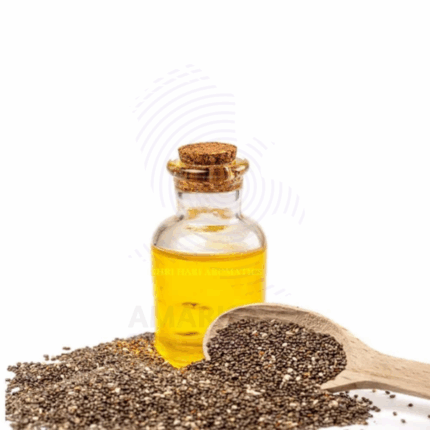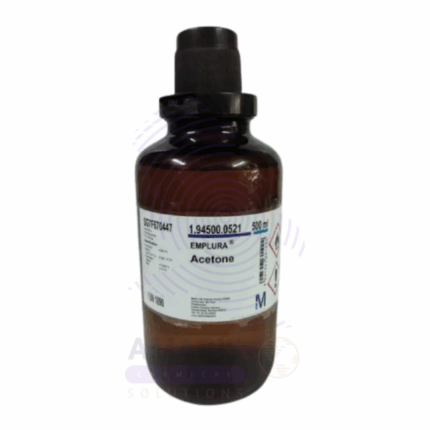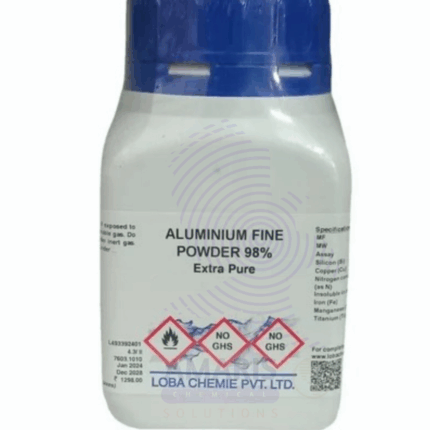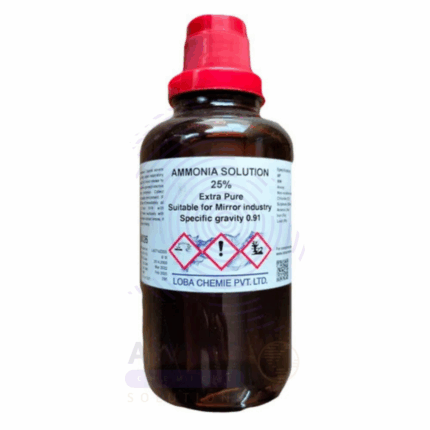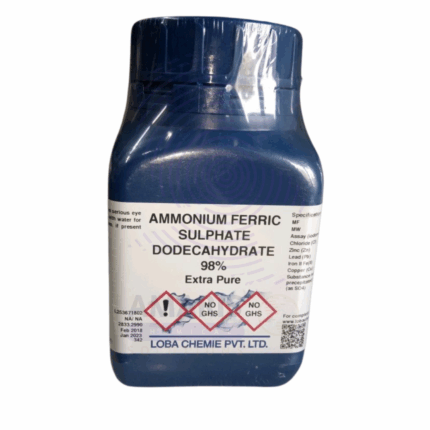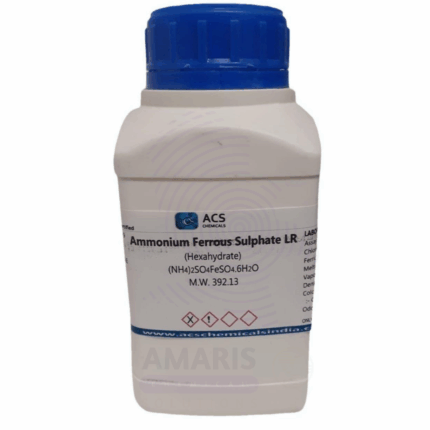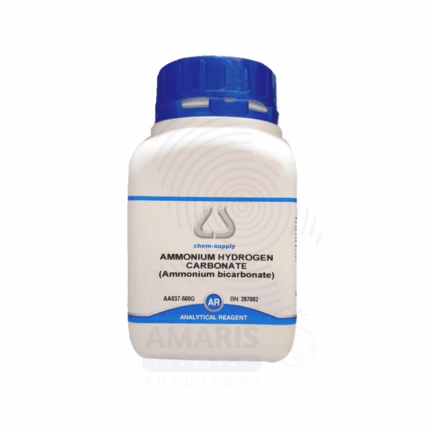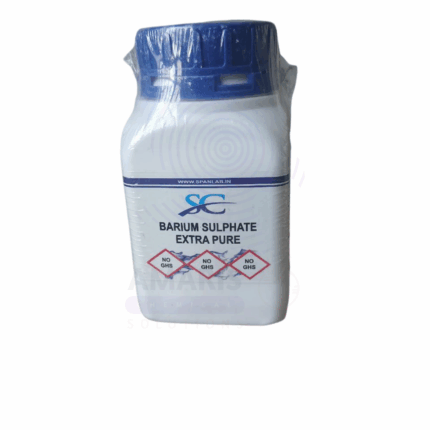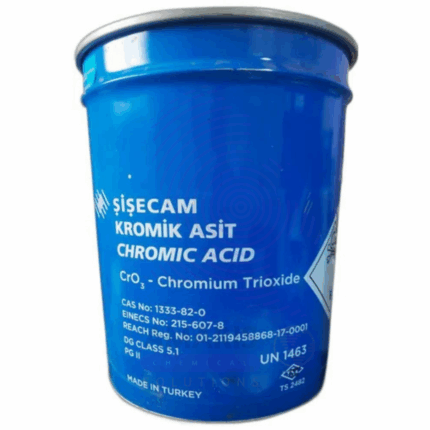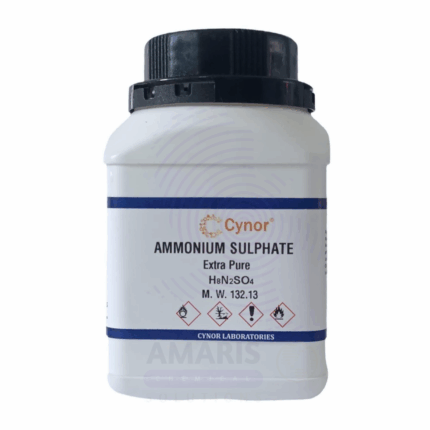
Ammonium Thiocyanate Extra Pure
$ 19.00 Original price was: $ 19.00.$ 18.54Current price is: $ 18.54.
Ammonium Thiocyanate Extra Pure is a high-purity, white to colorless crystalline compound highly soluble in water and alcohol, widely used in laboratory chemistry for analytical and coordination studies. It is commonly employed in the detection and quantification of iron(III) ions, forming a deep red complex that is useful in colorimetric analysis. Additionally, it serves as a reagent in the synthesis of thiocyanate complexes, photographic processing, and certain organic reactions. Its extra pure grade ensures low impurity levels, supporting accurate and reproducible results in sensitive assays and spectroscopic studies. The compound should be stored in a tightly sealed container, away from heat and moisture, to maintain its stability and effectiveness.
Ammonium Thiocyanate Extra Pure
Primary Uses
- Reagent for Iron(III) Detection (Blood-Red Complex Formation)
- Forms a deep blood-red complex Fe(SCN)6Fe(SCN)₆Fe(SCN)6³⁻ with Fe³⁺ ions — widely used in qualitative and colorimetric analysis of iron.
- Reagent in Spectrophotometric Iron Quantification
- Essential in UV-Vis spectroscopy to measure trace amounts of ferric iron in water, soil, or biological samples.
- Ligand in Coordination Chemistry
- Acts as a soft bidentate or ambidentate ligand forming stable complexes with transition metals (e.g., Co, Cu, Hg).
- Precursor in Organic Synthesis
- Used in the preparation of isothiocyanates, thioureas, and heterocyclic compounds in research synthesis.
- Educational Demonstrations of Color Reactions and Complex Ion Formation
- Popular for student labs involving complex ion equilibria, Le Chatelier’s principle, and ligand exchange.
Secondary Uses
- Reagent in Forensic and Toxicology Testing
- Sometimes used in color tests for detecting metal ions or cyanide derivatives in forensic analysis.
- Thermal Decomposition and Gas Release Studies
- Decomposes at elevated temperatures to release ammonia, sulfur compounds, and isothiocyanic acid — useful in thermal analysis or gas evolution studies.
- Corrosion and Metal Etching Research
- Investigated in surface treatment and corrosion behavior of metals in aggressive ionic environments.
- Component in Photographic and Darkroom Chemistry (Historical/Research Use)
- Occasionally used in silver halide processing or fixing bath formulas in photographic chemistry.
- Ion-Exchange and Chromatography Reagent
- Applied in separating lanthanides or actinides due to its complexing ability with various metal ions.
| PACK SIZE |
500 grams Plastic Tin |
|---|
1. Basic Identification Attributes
- Chemical Name: Ammonium Thiocyanate
- CAS Number: 1762-95-4
- HS Code: 28429090 (Other thiocyanates; ammonium thiocyanate under this general code)
- Molecular Formula: NH₄SCN
- Synonyms:
- Thiocyanic acid, ammonium salt
- Ammonium rhodanide
- Rhodan ammonium
2. Physical & Chemical Properties
- Physical State: Solid (crystalline powder)
- Color & Odor: White to colorless crystals; may have a faint sulfurous odor
- Boiling Point: Decomposes before boiling
- Melting Point: ~149–154 °C
- Density/Specific Gravity: ~1.305 g/cm³
- Solubility:
- Water: Very soluble (~128 g/100 mL at 20 °C)
- Alcohol: Soluble
- pH Level: ~4.5–6.5 (in 5% aqueous solution)
- Vapor Pressure: Negligible
- Flash Point: Not flammable
- Autoignition Temperature: Not applicable
- Viscosity: Not applicable
3. Safety & Hazard Attributes
- Hazard Class (GHS):
- Acute Toxicity – Oral (Category 4)
- Eye Irritation (Category 2A)
- Skin Irritation (Category 2)
- Environmental Hazard – Aquatic Acute (Category 2)
- NFPA Ratings:
- Health: 2
- Flammability: 0
- Reactivity: 0
- Exposure Limits:
- No established OSHA/ACGIH limits; treat as potentially toxic
- Reactivity:
- Stable under normal lab conditions
- Reacts with strong acids (releasing toxic gases like H₂S and CS₂)
- Decomposes at high temperature
4. Storage & Handling Attributes
- Storage Conditions:
- Store in a cool, dry, well-ventilated area
- Protect from light, moisture, and heat
- Incompatible Materials:
- Strong acids, oxidizers, nitrates, and metals (can release toxic gases)
- Container Type:
- Sealed plastic or glass container
- Shelf Life & Expiration Date:
- ~2–3 years when stored properly
- Special Handling Requirements:
- Use gloves, goggles, lab coat
- Handle in fume hood if heating or mixing with acids
5. Regulatory & Compliance Attributes
- Regulatory Status:
- Listed under TSCA, REACH
- Not controlled but regulated due to toxicity and aquatic hazard
- Transportation Restrictions:
- Not classified as hazardous for shipping in small quantities
- Waste Disposal Method:
- Treat as hazardous waste
- Avoid release into drains; collect and dispose via certified chemical waste handler
6. Environmental & Health Impact
- Ecotoxicity:
- Harmful to aquatic life; toxic to fish and invertebrates
- Persistence in Environment:
- May persist and accumulate in aquatic systems
- Carcinogenicity/Mutagenicity:
- Not classified as carcinogenic
- Biodegradability:
- Inorganic; not readily biodegradable
SAFETY PRECAUTIONS
- Personal Protective Equipment (PPE):
- Wear lab coat, chemical splash goggles, and nitrile or neoprene gloves.
- Use in a fume hood to avoid inhalation of vapors or dust.
- Handling:
- Avoid contact with eyes, skin, and clothing.
- Prevent inhalation of dust or fumes.
- Keep away from acids, oxidizing agents, and heat sources—may decompose to release toxic gases.
- Do not mix with metal salts unless purposefully intended under controlled conditions.
- Storage:
- Store in a tightly closed container in a cool, dry, well-ventilated area.
- Protect from heat, moisture, and light.
- Keep away from oxidizers, acids, and incompatible metals.
- Hygiene Measures:
- Wash hands thoroughly after use.
- Do not eat, drink, or smoke in work areas.
- Decontaminate surfaces and equipment after handling.
FIRST AID MEASURES
- Inhalation:
- Move person to fresh air.
- If breathing is difficult, administer oxygen and seek immediate medical attention.
- May cause irritation to the respiratory tract.
- Skin Contact:
- Wash affected area with plenty of soap and water.
- Remove contaminated clothing.
- Seek medical attention if irritation or symptoms develop.
- Eye Contact:
- Rinse cautiously with water for at least 15 minutes.
- Remove contact lenses if present.
- Seek immediate medical advice.
- Ingestion:
- Rinse mouth with water.
- Do not induce vomiting.
- If the person is conscious, give water to dilute.
- Seek medical attention immediately — thiocyanates can interfere with thyroid function and are toxic in large doses.
FIRE FIGHTING MEASURES
- Suitable Extinguishing Media:
- Use dry chemical, carbon dioxide (CO₂), foam, or water spray as appropriate for surrounding materials.
- Specific Hazards:
- Not highly flammable but may decompose on heating, releasing:
- Toxic fumes of hydrogen cyanide (HCN)
- Sulfur oxides (SOₓ)
- Ammonia
- Nitrogen oxides (NOₓ)
- Not highly flammable but may decompose on heating, releasing:
- Protective Equipment for Firefighters:
- Wear self-contained breathing apparatus (SCBA) and full protective gear.
- Firefighting Instructions:
- Use water spray to cool fire-exposed containers.
- Avoid inhalation of smoke or decomposition products.
- Contain runoff—toxic to aquatic life and may contaminate water supplies.


 Preservatives(food)
Preservatives(food) Flavor Enhancers
Flavor Enhancers Acidulants
Acidulants Sweeteners
Sweeteners Antioxidants
Antioxidants Colorants(food)
Colorants(food) Nutraceutical Ingredients (food)
Nutraceutical Ingredients (food) Nutrient Supplements
Nutrient Supplements Emulsifiers
Emulsifiers
 Collectors
Collectors Dust Suppressants
Dust Suppressants Explosives and Blasting Agents
Explosives and Blasting Agents Flocculants and Coagulants
Flocculants and Coagulants Frothers
Frothers Leaching Agents
Leaching Agents pH Modifiers
pH Modifiers Precious Metal Extraction Agents
Precious Metal Extraction Agents
 Antioxidants(plastic)
Antioxidants(plastic) Colorants (Pigments, Dyes)
Colorants (Pigments, Dyes) Fillers and Reinforcements
Fillers and Reinforcements Flame Retardants
Flame Retardants Monomers
Monomers Plasticizers
Plasticizers Polymerization Initiators
Polymerization Initiators Stabilizers (UV, Heat)
Stabilizers (UV, Heat)
 Antifoaming Agents
Antifoaming Agents Chelating Agents
Chelating Agents Coagulants and Flocculants
Coagulants and Flocculants Corrosion Inhibitors
Corrosion Inhibitors Disinfectants and Biocides
Disinfectants and Biocides Oxidizing Agents
Oxidizing Agents pH Adjusters
pH Adjusters Scale Inhibitors( water)
Scale Inhibitors( water)
 Antioxidants(cosmetic)
Antioxidants(cosmetic) Emollients
Emollients Fragrances and Essential Oils
Fragrances and Essential Oils Humectants
Humectants Preservatives
Preservatives Surfactants(cosmetic)
Surfactants(cosmetic) Thickeners
Thickeners UV Filters
UV Filters
 Fertilizers
Fertilizers Soil Conditioners
Soil Conditioners Plant Growth Regulators
Plant Growth Regulators Animal Feed Additives
Animal Feed Additives Biostimulants
Biostimulants Pesticides (Herbicides, Insecticides, Fungicides)
Pesticides (Herbicides, Insecticides, Fungicides)
 Active Pharmaceutical Ingredients (APIs)
Active Pharmaceutical Ingredients (APIs) Excipients
Excipients Solvents(pharmaceutical)
Solvents(pharmaceutical) Antibiotics
Antibiotics Antiseptics and Disinfectants
Antiseptics and Disinfectants Vaccine Adjuvants
Vaccine Adjuvants Nutraceutical Ingredients (pharmaceutical)
Nutraceutical Ingredients (pharmaceutical) Analgesics & Antipyretics
Analgesics & Antipyretics
 Analytical Reagents
Analytical Reagents Solvents(lab)
Solvents(lab) Chromatography Chemicals
Chromatography Chemicals Spectroscopy Reagents
Spectroscopy Reagents microbiology-and-cell-culture-reagents
microbiology-and-cell-culture-reagents Molecular Biology Reagents
Molecular Biology Reagents Biochemical Reagents
Biochemical Reagents Inorganic and Organic Standards
Inorganic and Organic Standards Laboratory Safety Chemicals
Laboratory Safety Chemicals Specialty Laboratory Chemicals(Special Laboratory Equipment)
Specialty Laboratory Chemicals(Special Laboratory Equipment)
 Demulsifiers
Demulsifiers Hydraulic Fracturing Fluids
Hydraulic Fracturing Fluids Scale Inhibitors(oil)
Scale Inhibitors(oil) Surfactants(oil)
Surfactants(oil) Drilling Fluids
Drilling Fluids
 Dyes and Pigments
Dyes and Pigments Bleaching Agents
Bleaching Agents Softening Agents
Softening Agents Finishing Agents
Finishing Agents Antistatic Agents
Antistatic Agents
 Admixtures
Admixtures Waterproofing Agents
Waterproofing Agents Sealants and Adhesives
Sealants and Adhesives Curing Compounds
Curing Compounds Concrete Repair Chemicals
Concrete Repair Chemicals Anti-Corrosion Coatings
Anti-Corrosion Coatings
 Surfactants(cleaning)
Surfactants(cleaning) Builders
Builders Enzymes
Enzymes Solvents (Cleaning)
Solvents (Cleaning) Fragrances
Fragrances
 Electronic Chemicals
Electronic Chemicals Catalysts
Catalysts Lubricants
Lubricants Photographic Chemicals
Photographic Chemicals Refrigerants
Refrigerants Automotive chemicals
Automotive chemicals Pyrotechnic Chemicals
Pyrotechnic Chemicals
 Biodegradable Surfactants
Biodegradable Surfactants Bio-based Solvents
Bio-based Solvents Renewable Polymers
Renewable Polymers Carbon Capture Chemicals
Carbon Capture Chemicals Wastewater Treatment Chemicals
Wastewater Treatment Chemicals
 Pigments
Pigments Solvents(paint)
Solvents(paint) Specialty Coatings
Specialty Coatings Binders/Resins
Binders/Resins Additives
Additives Driers
Driers Anti-Corrosion Agents
Anti-Corrosion Agents Functional Coatings
Functional Coatings Application-Specific Coatings
Application-Specific Coatings
 Fresh Herbs
Fresh Herbs Ground Spices
Ground Spices Whole Spices
Whole Spices Spice Blends
Spice Blends Dried Herbs
Dried Herbs
 Leavening Agents
Leavening Agents Dough Conditioners
Dough Conditioners Flour Treatments
Flour Treatments Fat Replacers
Fat Replacers Decoratives
Decoratives Preservatives(baking)
Preservatives(baking)
 Plasticizers & Softeners
Plasticizers & Softeners Reinforcing Agents
Reinforcing Agents Adhesion Promoters
Adhesion Promoters Vulcanizing Agents
Vulcanizing Agents Antidegradants
Antidegradants Blowing Agents
Blowing Agents Fillers & Extenders
Fillers & Extenders Accelerators & Retarders
Accelerators & Retarders
